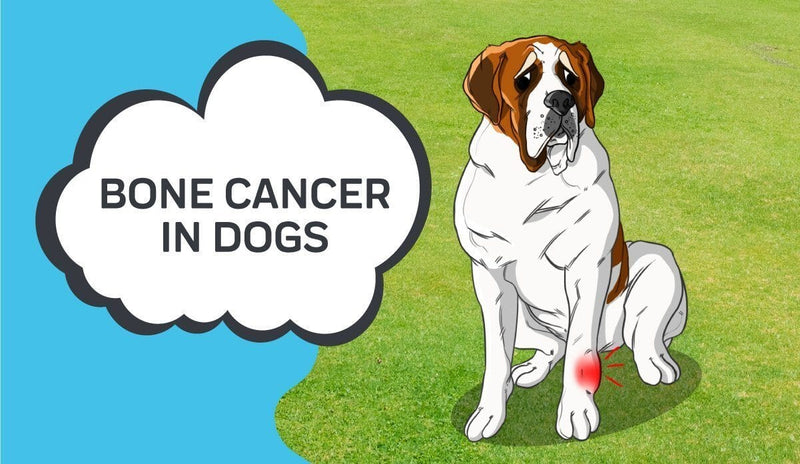- How Do Dogs Get Skin Cancer?
- What Exactly is Dog Skin Cancer?
- Types of Dog Skin Cancer
- Symptoms of Skin Cancers in Dogs
- How Skin Cancer in Dogs is Diagnosed
- How to Treat Skin Cancer in Dogs
- How to Prevent Skin Cancer in Dogs
How Do Dogs Get Skin Cancer?
Dog skin cancer doesn't pop up out of anywhere or without a reasonable cause. As the owner of a dog with skin cancer, you may be asking the question, "How do dogs get skin cancer?" And we applaud you for that because it shows you're proactive about your dog's skin health!
When you know the answer to the question you can better protect against the causes of canine cancer of the skin. There are a few ways that dogs can get cancer, the most obvious and likely of which is from too much sun exposure.
What Exactly is Dog Skin Cancer?

Skin cancer is a serious health concern resulting from a disruption in the normal process of skin cell growth. It's important to note that not only do the quickly developing skin cells need to be abnormal, but they also have to be the cells multiplying at a rapid rate. When skin cells start to multiply at a rate so rapid the body cannot control the behavior of the cells, the cancerous cells slowly but surely begin outnumbering the healthy ones. Since the harmful activity takes place in layers of your dog's skin, it is considered skin cancer, just as cancer of other organs would be cancer of that respective part of the body.
Types of Dog Skin Cancer
Like humans, dogs are susceptible to receiving a cancer diagnosis at some point in their lives. When it comes to the different types of this disease in dogs, there are three very common types of canine skin cancers that pet owners should know about, including:
- Malignant Melanoma
- Mast Cell Tumors
- Squamous Cell Carcinoma
Malignant Melanoma
Though melanoma can present as both benign and malignant tumors, if the cancer is malignant it is denoted by the presence of malignant tumors. Usually, the tumors that appear in cases of malignant melanomas are dark, but sometimes, the tumors won't be dark at all, but instead, they'll look like parts of the skin that are void of pigment altogether.
This drastic difference in the possible aesthetics of skin tumors makes it confusing to know how you're supposed to be able to determine if your pet has malignant tumors, which is understandable. Instead of focusing on the coloration of the tumors, we suggest looking more closely at the location of the tumors instead.
Malignant cancer will result in tumors on the lips, around the mouth, on the head, against the neck, near your pet's nail beds, or somewhere close to the scrotum of your pet. Sometimes, the skin tumors will become irritated, which results in puffiness and swelling near the malignant melanomas.
Skin tumors of this nature can quickly become metastasized, so you must contact your vet right away should you notice tumors like these on your pet. When tumors are metastatic, there is a higher risk of cancerous cells invading the surrounding lymph nodes. Once the lymph nodes are affected by malignant tumors, your pet has a greater chance of developing cancer in other parts of the body as well.
Mast Cell Tumors

The type of tumor known as mast cell tumors is related to allergies in dogs. Not subjected to only one part of your pet's body, mast cell tumors are a type of tumor that can realistically be found anywhere in your dog's body. This makes it harder to specifically check for a mast cell tumor because it could be anywhere.
A mast cell tumor is not necessarily always an aggressive form of cancer, though it can grow to be quite concerning if it is left untreated for far too long. It is thought that mast cell tumors are a type of skin cancer that dogs are genetically predisposed to seeing as certain dog breeds have a higher chance of developing these tumors.
Squamous Cell Carcinoma
Squamous cell carcinoma is a type of cancer that comes about in the epidermis of your dog's skin. Often mistaken as another cell carcinomas, oral squamous cell carcinomas is another name for squamous cell carcinomas. Squamous Cell Carcinoma is a type of skin cancer that can form in dogs. Squamous cell carcinomas are usually caused by ultraviolet radiation and tend to occur in places where the sun often hits such as ears, nose, lips, or eyelids. These tumors originate from cells called keratinocytes which produce protective lubricating oils for your pet's coat, but when these cells mutate they stop producing this oil leaving it with an abnormal appearance.
Symptoms of Skin Cancers in Dogs
Skin tumors are certainly the most obvious symptom of this disease, but they are not the only side effect to look for. Many other symptoms signify your dog might have one of the types of skin cancer, including:
- Unexplainable inflammation
- Redness or constant itching
- Discoloration in certain areas
- Gnawing on parts of their fur
- Absence of hair in a specific spot on their bodies
- Preoccupied with cleaning themselves
- Hiding away and keeping to themselves
- Isolating in other rooms
- Unwillingness to be pet
- Total disinterest in playtime
- No excitement surrounding walks
Additionally, did you know that a weakened immune system can contribute to higher rates of skin cancer in dogs? If your dog is immunocompromised for any reason, it won't hurt to have your dog checked for possible skin tumors more frequently, just for the sake of erring on the side of caution.
How Skin Cancer in Dogs is Diagnosed
The diagnosis for this disease can only come about as a result of medical testing, which ranges from X-rays to invasive examinations. The specific diagnostic test that the vet conducts on your dog will relate more to the types of skin cancer the vet suspects your dog has, and then the vet will be able to draw conclusions from there.
That being said, in almost every case, your dog's vet will take a closer look at the cells that the questionable and potentially cancerous tumor comprises. The option for an X-ray or CT scan is likely a starting point for vets trying to figure out if your dog has skin cancer, especially if the vet is having difficulty locating the skin tumor in the first place.
From there, if invasive procedures are required, there are two main diagnostic options that the vet is highly likely to consider. The first possible invasive test is a popular option, and it's what is known as a biopsy. Biopsies are procedures in which professionals take part of the concerning lump and send the piece to pathologists for the sake of being viewed more closely. The results that are sent back indicate whether the tumor-like cells are either cancerous or harmless.
The other option for invasive procedures intended to diagnose the cancer in dogs is something known as fine-needle aspiration. Instead of taking an actual piece from the whole, fine needle aspiration procedures extract cells from the lump of skin, and they are reviewed as a sample to determine if cancer is the cause of the skin abnormality.
How to Treat Skin Cancer in Dogs

Another one of the canine skin cancer treatment options is an operation, which would require your dog to go under anesthesia. The surgical removal of your dog's skin cancer tumor might be necessary for your pet.
Surgical removal of a skin tumor is often suggested for dogs with tumors that run the risk of becoming metastatic. There are a few treatment options for dogs with this cancer. Radiation therapy is often one of the many viable treatment options. Still, radiation therapy can pose a threat to elderly dogs because it does cause pets to feel very sick to their stomachs.
How to Prevent Skin Cancer in Dogs
Preventative measures can be taken to lower the likelihood of your pets contracting cancer at some point in their lives. You cannot always protect your dog against cancer because the unfortunate disease has the potential to affect just about any and every dog out there. Even though there are many instances in which cancer is unpredictable and not rooted in any cause outside of pure unluckiness, some predispositions and lifestyle choices can contribute to a cancer diagnosis for your dog.
One of the most prevention-oriented steps you can take for your dog is limiting how much exposure to the sun they experience. Of course, we're not suggesting that you keep your dog away from sunlight at all hours of the day, but it's good practice to monitor how long your dog is in direct sunshine, especially on extraordinarily warm days. The lighter the coat color of your dog, the more attention you should pay to their time under the sun.
If you have specific questions regarding your dog's predispositions to canine skin cancers, voice your concerns to your dog's veterinarian. They can speak to the situation with a backstory in mind, which will provide you with a more accurate understanding of your dog's risk for skin cancer!
Sources:
Dogs and Skin CancerDog Skin Cancer: Types, Symptoms, and Treatment
What Is Cancer?
Top 5 Cancers in Dogs
Dog Cancer - Symptoms, Diagnosis & Treatment
Skin Cancer in Dogs

Thanks for stopping by!
P.S. We Love You!
Sincerely,
The Innovet Team
Please do not ask for emergency or specific medical questions about your pets in the comments. Innovet Pet Products is unable to provide you with specific medical advice or counseling. A detailed physical exam, patient history, and an established veterinarian are required to provide specific medical advice. If you are worried that your pet requires emergency attention or if you have specific medical questions related to your pet’s current or chronic health conditions, please contact or visit your local/preferred veterinarian, an animal-specific poison control hotline, or your local emergency veterinary care center.
Please share your experiences and stories, your opinions and feedback about this blog, or what you've learned that you'd like to share with others.
LEARN MORE
Best Selling












 CBD Oil for Dogs
CBD Oil for Dogs Advanced Mobility Support Chews for Dogs
Advanced Mobility Support Chews for Dogs All Natural Oatmeal & Honey Shampoo + Conditioner for Dogs
All Natural Oatmeal & Honey Shampoo + Conditioner for Dogs CBD Dog Treats
CBD Dog Treats




